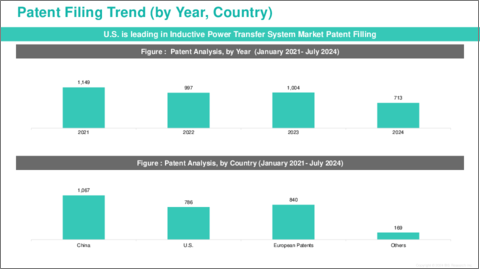|
|
市場調査レポート
商品コード
1545610
電磁誘導型電力伝送システム市場- 世界および地域別分析:用途別、製品別、競合情勢 - 分析と予測(2024年~2034年)Inductive Power Transfer System Market - A Global and Regional Analysis: Focus on Application, Product, and Competitive Landscape - Analysis and Forecast, 2024-2034 |
||||||
カスタマイズ可能
|
|||||||
| 電磁誘導型電力伝送システム市場- 世界および地域別分析:用途別、製品別、競合情勢 - 分析と予測(2024年~2034年) |
|
出版日: 2024年09月02日
発行: BIS Research
ページ情報: 英文 110 Pages
納期: 1~5営業日
|
全表示
- 概要
- 目次
電磁誘導型電力伝送システム(IPT)市場は、利便性と効率性を高める革新的なワイヤレスパワーソリューションに焦点を当て、より広範なエネルギー・技術セクターの中で急速に発展しています。
2024年の市場規模は275億米ドルで、CAGR 26.1%の大幅な成長が予測され、2034年には約2,805億米ドルに達するとみられています。
IPTシステムは、さまざまな用途でワイヤレスエネルギー伝送を可能にすることで、物理的なコネクターの必要性を減らし、ユーザーの利便性を向上させることで、電力伝送に変革的なアプローチを提供します。この技術は、産業界や消費者がより効率的で適応性の高いエネルギーソリューションを求めるにつれて支持を集めています。IPTシステムへの関心が高まっている背景には、充電プロセスを簡素化し、業務効率を向上させ、電気自動車やその他の先端技術の採用をサポートする可能性があることがあります。
| 主要市場統計 | |
|---|---|
| 予測期間 | 2024年~2034年 |
| 2024年の評価額 | 275億米ドル |
| 2034年の予測 | 2,805億米ドル |
| CAGR | 26.1% |
技術が進化し、ワイヤレスソリューションへの需要が高まるにつれ、IPT市場は大きく拡大する態勢を整えています。民生用電子機器、自動車、ヘルスケア、公共インフラ、産業部門にまたがる最新の用途では、よりスマートで柔軟な電力ソリューションに向けた世界の動向に合わせながら、エネルギーニーズを満たすためにIPTシステムを取り入れる動きが加速しています。
当レポートでは、世界の電磁誘導型電力伝送システム市場について調査し、市場の概要とともに、用途別、製品別、地域別の動向、および市場に参入する企業のプロファイルなどを提供しています。
目次
エグゼクティブサマリー
第1章 市場:業界の展望
- 動向:現在および将来の影響評価
- サプライチェーンの概要
- R&Dレビュー
- 規制状況
- ステークホルダー分析
- 市場力学の概要
- スタートアップ資金調達の概要
第2章 電磁誘導型電力伝送システム市場、用途別
- 用途の概要
- 電磁誘導型電力伝送システム市場、用途別
第3章 電磁誘導型電力伝送システム市場、製品別
- 製品概要
- 電磁誘導型電力伝送システム市場、電力範囲別
- 電磁誘導型電力伝送システム市場、技術別
- 電磁誘導型電力伝送システム市場、システム別
第4章 電磁誘導型電力伝送システム市場、地域別
- 電磁誘導型電力伝送システム市場- 地域別
- 北米
- 欧州
- アジア太平洋
- その他の地域
第5章 市場-競合ベンチマーキングと企業プロファイル
- 今後の見通し
- 地域分析
- 競合ベンチマーキング
- 企業プロファイル
- SAMSUNG
- Qualcomm Technologies, Inc.
- WiTricity Corporation
- Wi-Charge Ltd
- ConvenientPower
- Powermat
- NXP Semiconductors
- STMicroelectronics
- Texas Instruments Incorporated
- Ossia Inc.
- Conductix-Wampfler
- TOSHIBA CORPORATION
- PLUGLESS POWER INC.
- Salcomp
- Continental AG
- その他の主要企業
第6章 調査手法
Introduction to Inductive Power Transfer System Market
The inductive power transfer system (IPT) market is rapidly advancing within the broader energy and technology sector, focusing on innovative wireless power solutions that enhance convenience and efficiency. Valued at $27.5 billion in 2024, the market is projected to experience substantial growth, with a CAGR of 26.1%, potentially reaching approximately $280.5 billion by 2034.
IPT systems offer a transformative approach to power transfer by enabling wireless energy delivery across various applications, thereby reducing the need for physical connectors and enhancing user convenience. This technology is gaining traction as industries and consumers seek more efficient and adaptable energy solutions. The growing interest in IPT systems is driven by their potential to simplify charging processes, improve operational efficiency, and support the adoption of electric vehicles and other advanced technologies.
| KEY MARKET STATISTICS | |
|---|---|
| Forecast Period | 2024 - 2034 |
| 2024 Evaluation | $27.5 Billion |
| 2034 Forecast | $280.5 Billion |
| CAGR | 26.1% |
As technology evolves and the demand for wireless solutions increases, the IPT market is poised for significant expansion. Modern applications across consumer electronics, automotive, healthcare, public infrastructure, and industrial sectors are increasingly incorporating IPT systems to meet energy needs while aligning with global trends towards smarter and more flexible power solutions.
The inductive power transfer system market is segmented based on application, power range, technology, system type, and region. Key application segments include consumer electronics, automotive, healthcare, public infrastructure, industrial, and others, each benefiting from the unique advantages of IPT technology. The market is further divided by power range-low power (up to 50W), medium power (51W to 3kW), and high power (above 3kW)-and by technology, including inductive coupling, magnetic resonant induction, microwave power transfer, and others.
Regional dynamics play a crucial role in shaping the inductive power transfer system market. The Asia-Pacific region is leading the market, driven by rapid urbanization, technological advancements, and significant investments in smart infrastructure. Countries in this region are increasingly adopting IPT technologies to meet the growing demand for efficient energy solutions and to support extensive urban development. The Asia-Pacific market is characterized by high adoption rates and large-scale implementation of IPT systems, positioning it as a key driver of global growth.
North America follows with its advanced technological infrastructure and substantial investments in wireless power technologies. The U.S. is at the forefront, with extensive research initiatives and a robust technological landscape driving the adoption of IPT systems. A significant recent development occurred on May 20, 2024, when WiTricity and International Transportation Service (ITS) launched a groundbreaking pilot program at the Port of Long Beach. This initiative features the first Ford E-Transit equipped with WiTricity's wireless charging technology, underscoring North America's role in advancing IPT technology.
Europe also plays a critical role with a strong focus on innovation and sustainable energy solutions. The region is actively integrating inductive power transfer systems into various applications, reflecting its commitment to reducing environmental impact and enhancing energy efficiency. Europe's emphasis on cutting-edge technology is evident in its adoption of IPT systems to support cleaner energy transitions.
A notable instance of inductive power transfer system integration occurred on July 15, 2023, when Electreon installed its wireless charging infrastructure in several countries, including Israel, the US, Germany, Italy, Sweden, and Norway. Electreon's technology, based on magnetic resonance induction with copper coils embedded under roadways, exemplifies the growing trend of incorporating inductive power transfer systems into smart public infrastructure projects. This development highlights the increasing global adoption of advanced energy solutions and supports the shift towards more efficient and sustainable public transport options.
Key players in the IPT market include SAMSUNG, Qualcomm Technologies, Inc., WiTricity Corporation, Wi-Charge Ltd, and ConvenientPower. These companies are driving market expansion through innovation, strategic partnerships, and advancements in technology. The ongoing development of IPT systems underscores the market's potential to revolutionize power transfer across various applications, offering a more convenient, efficient, and sustainable approach to energy delivery.
Market Segmentation:
Segmentation 1: by Application
- Consumer Electronics
- Automotive
- Healthcare
- Public Infrastructure
- Industrial
- Others
Segmentation 2: by Power Range
- Low Power (Upto 50W)
- Medium Power (51W to 3kW)
- High Power (above 3kW)
Segmentation 3: by Technology
- Inductive Coupling
- Magnetic Resonant Induction
- Microwave Power Transfer
- Others
Segmentation 4: by System
- Stationary Charging System
- Dynamic Charging System
- Portable Charging System
Segmentation 5: by Region
- North America
- Europe
- Asia-Pacific
- Rest-of-the-World
How can this report add value to an organization?
Product/Innovation Strategy: The global inductive power transfer system market has been extensively segmented based on various categories, such as application, power range, technology, and system. This can help readers get a clear overview of which segments account for the largest share and which ones are well-positioned to grow in the coming years.
Competitive Strategy: A detailed competitive benchmarking of the players operating in the global inductive power transfer system market has been done to help the reader understand how players stack against each other, presenting a clear market landscape. Additionally, comprehensive competitive strategies such as partnerships, agreements, and collaborations will aid the reader in understanding the untapped revenue pockets in the market.
Key Market Players and Competition Synopsis
The companies that are profiled have been selected based on thorough secondary research, which includes analyzing company coverage, product portfolio, market penetration, and insights gathered from primary experts.
Some of the prominent companies in this market are:
- SAMSUNG
- Qualcomm Technologies, Inc.
- WiTricity Corporation
- Powermat
- Ossia Inc.
- NXP Semiconductors
Key Questions Answered in this Report:
- What are the main factors driving demand in the inductive power transfer system market?
- What are the significant patents filed by companies in the inductive power transfer system market?
- Who are the key players in the inductive power transfer system market, and what are their respective market shares?
- What prominent partnerships or collaborations exist among stakeholders in the inductive power transfer system market?
- What strategies are key companies employing to gain a competitive edge in the inductive power transfer system market?
- What is the future outlook for the inductive power transfer system market in terms of growth potential?
- What is the current market valuation of the inductive power transfer system market, and what growth trajectory is projected from2024 to 2034?
- Which application and product segments are expected to lead the inductive power transfer system market over the forecast period (2024-2034)?
- Which regions show the highest adoption rates for inductive power transfer systems, and what factors contribute to their leadership?
Table of Contents
Executive Summary
Scope and Definition
Market/Product Definition
Key Questions Answered
Analysis and Forecast Note
1. Markets: Industry Outlook
- 1.1 Trends: Current and Future Impact Assessment
- 1.1.1 Integration with Autonomous Vehicles
- 1.1.2 Advancements in High-Power Charging Technologies
- 1.2 Supply Chain Overview
- 1.2.1 Value Chain Analysis
- 1.2.2 Pricing Forecast
- 1.3 R&D Review
- 1.3.1 Patent Filing Trend by Country, by Company
- 1.4 Regulatory Landscape
- 1.5 Stakeholder Analysis
- 1.6 Market Dynamics Overview
- 1.6.1 Market Drivers
- 1.6.2 Market Restraints
- 1.6.3 Market Opportunities
- 1.7 Startup Funding Summary
2. Inductive Power Transfer System Market by Application
- 2.1 Application Summary
- 2.2 Inductive Power Transfer System Market, by Application
- 2.2.1 Consumer Electronics
- 2.2.2 Automotive
- 2.2.3 Healthcare
- 2.2.4 Public Infrastructure
- 2.2.5 Industrial
- 2.2.6 Others
3. Inductive Power Transfer System Market by Products
- 3.1 Product Summary
- 3.2 Inductive Power Transfer System Market, by Power Range
- 3.2.1 Low Power (Up to 50W)
- 3.2.2 Medium Power (51W to 3kW)
- 3.2.3 High Power (above 3kW)
- 3.3 Inductive Power Transfer System Market, by Technology
- 3.3.1 Inductive Coupling
- 3.3.2 Magnetic Resonant Induction
- 3.3.3 Microwave Power Transfer
- 3.3.4 Others
- 3.4 Inductive Power Transfer System Market, by System
- 3.4.1 Stationary Charging System
- 3.4.2 Dynamic Charging System
- 3.4.3 Portable Charging System
4. Inductive Power Transfer System Market by Region
- 4.1 Inductive Power Transfer System Market - by Region
- 4.2 North America
- 4.2.1 Regional Overview
- 4.2.1.1 Driving Factors for Market Growth
- 4.2.1.2 Factors Challenging the Market
- 4.2.2 Application
- 4.2.3 Product
- 4.2.4 North America (by Country)
- 4.2.4.1 U.S.
- 4.2.4.1.1 Market by Application
- 4.2.4.1.2 Market by Product
- 4.2.4.2 Canada
- 4.2.4.2.1 Market by Application
- 4.2.4.2.2 Market by Product
- 4.2.4.3 Mexico
- 4.2.4.3.1 Market by Application
- 4.2.4.3.2 Market by Product
- 4.2.4.1 U.S.
- 4.2.1 Regional Overview
- 4.3 Europe
- 4.3.1 Regional Overview
- 4.3.1.1 Driving Factors for Market Growth
- 4.3.1.2 Factors Challenging the Market
- 4.3.2 Application
- 4.3.3 Product
- 4.3.4 Europe (by Country)
- 4.3.4.1 Germany
- 4.3.4.1.1 Market by Application
- 4.3.4.1.2 Market by Product
- 4.3.4.2 France
- 4.3.4.2.1 Market by Application
- 4.3.4.2.2 Market by Product
- 4.3.4.3 U.K
- 4.3.4.3.1 Market by Application
- 4.3.4.3.2 Market by Product
- 4.3.4.4 Italy
- 4.3.4.4.1 Market by Application
- 4.3.4.4.2 Market by Product
- 4.3.4.5 Rest-of-Europe
- 4.3.4.5.1 Market by Application
- 4.3.4.5.2 Market by Product
- 4.3.4.1 Germany
- 4.3.1 Regional Overview
- 4.4 Asia-Pacific
- 4.4.1 Regional Overview
- 4.4.1.1 Driving Factors for Market Growth
- 4.4.1.2 Factors Challenging the Market
- 4.4.2 Application
- 4.4.3 Product
- 4.4.4 Asia-Pacific (by Country)
- 4.4.4.1 China
- 4.4.4.1.1 Market by Application
- 4.4.4.1.2 Market by Product
- 4.4.4.2 Japan
- 4.4.4.2.1 Market by Application
- 4.4.4.2.2 Market by Product
- 4.4.4.3 Australia
- 4.4.4.3.1 Market by Application
- 4.4.4.3.2 Market by Product
- 4.4.4.4 South Korea
- 4.4.4.4.1 Market by Application
- 4.4.4.4.2 Market by Product
- 4.4.4.5 Rest-of-Asia-Pacific
- 4.4.4.5.1 Market by Application
- 4.4.4.5.2 Market by Product
- 4.4.4.1 China
- 4.4.1 Regional Overview
- 4.5 Rest-of-the-World (by Region)
- 4.5.1 Regional Overview
- 4.5.1.1 Driving Factors for Market Growth
- 4.5.1.2 Factors Challenging the Market
- 4.5.2 Application
- 4.5.3 Product
- 4.5.4 Rest-of-the-World (by Region)
- 4.5.4.1 South America
- 4.5.4.1.1 Market by Application
- 4.5.4.1.2 Market by Product
- 4.5.4.2 Middle East and Africa
- 4.5.4.2.1 Market by Application
- 4.5.4.2.2 Market by Product
- 4.5.4.1 South America
- 4.5.1 Regional Overview
5. Markets- Competitive Benchmarking and Companies Profiled
- 5.1 Next Frontier
- 5.2 Geographical Analysis
- 5.3 Competitive Benchmarking
- 5.4 Company Profiles
- 5.4.1 SAMSUNG
- 5.4.1.1 Overview
- 5.4.1.2 Top Products / Product Portfolio
- 5.4.1.3 Top Competitors
- 5.4.1.4 Target Customers/End-Users
- 5.4.1.5 Key Personnel
- 5.4.1.6 Analyst View
- 5.4.1.7 Market Share
- 5.4.2 Qualcomm Technologies, Inc.
- 5.4.2.1 Overview
- 5.4.2.2 Top Products / Product Portfolio
- 5.4.2.3 Top Competitors
- 5.4.2.4 Target Customers/End-Users
- 5.4.2.5 Key Personnel
- 5.4.2.6 Analyst View
- 5.4.2.7 Market Share
- 5.4.3 WiTricity Corporation
- 5.4.3.1 Overview
- 5.4.3.2 Top Products / Product Portfolio
- 5.4.3.3 Top Competitors
- 5.4.3.4 Target Customers/End-Users
- 5.4.3.5 Key Personnel
- 5.4.3.6 Analyst View
- 5.4.3.7 Market Share
- 5.4.4 Wi-Charge Ltd
- 5.4.4.1 Overview
- 5.4.4.2 Top Products / Product Portfolio
- 5.4.4.3 Top Competitors
- 5.4.4.4 Target Customers/End-Users
- 5.4.4.5 Key Personnel
- 5.4.4.6 Analyst View
- 5.4.4.7 Market Share
- 5.4.5 ConvenientPower
- 5.4.5.1 Overview
- 5.4.5.2 Top Products / Product Portfolio
- 5.4.5.3 Top Competitors
- 5.4.5.4 Target Customers/End-Users
- 5.4.5.5 Key Personnel
- 5.4.5.6 Analyst View
- 5.4.5.7 Market Share
- 5.4.6 Powermat
- 5.4.6.1 Overview
- 5.4.6.2 Top Products / Product Portfolio
- 5.4.6.3 Top Competitors
- 5.4.6.4 Target Customers/End-Users
- 5.4.6.5 Key Personnel
- 5.4.6.6 Analyst View
- 5.4.6.7 Market Share
- 5.4.7 NXP Semiconductors
- 5.4.7.1 Overview
- 5.4.7.2 Top Products / Product Portfolio
- 5.4.7.3 Top Competitors
- 5.4.7.4 Target Customers/End-Users
- 5.4.7.5 Key Personnel
- 5.4.7.6 Analyst View
- 5.4.7.7 Market Share
- 5.4.8 STMicroelectronics
- 5.4.8.1 Overview
- 5.4.8.2 Top Products / Product Portfolio
- 5.4.8.3 Top Competitors
- 5.4.8.4 Target Customers/End-Users
- 5.4.8.5 Key Personnel
- 5.4.8.6 Analyst View
- 5.4.8.7 Market Share
- 5.4.9 Texas Instruments Incorporated
- 5.4.9.1 Overview
- 5.4.9.2 Top Products / Product Portfolio
- 5.4.9.3 Top Competitors
- 5.4.9.4 Target Customers/End-Users
- 5.4.9.5 Key Personnel
- 5.4.9.6 Analyst View
- 5.4.9.7 Market Share
- 5.4.10 Ossia Inc.
- 5.4.10.1 Overview
- 5.4.10.2 Top Products / Product Portfolio
- 5.4.10.3 Top Competitors
- 5.4.10.4 Target Customers/End-Users
- 5.4.10.5 Key Personnel
- 5.4.10.6 Analyst View
- 5.4.10.7 Market Share
- 5.4.11 Conductix-Wampfler
- 5.4.11.1 Overview
- 5.4.11.2 Top Products / Product Portfolio
- 5.4.11.3 Top Competitors
- 5.4.11.4 Target Customers/End-Users
- 5.4.11.5 Key Personnel
- 5.4.11.6 Analyst View
- 5.4.11.7 Market Share
- 5.4.12 TOSHIBA CORPORATION
- 5.4.12.1 Overview
- 5.4.12.2 Top Products / Product Portfolio
- 5.4.12.3 Top Competitors
- 5.4.12.4 Target Customers/End-Users
- 5.4.12.5 Key Personnel
- 5.4.12.6 Analyst View
- 5.4.12.7 Market Share
- 5.4.13 PLUGLESS POWER INC.
- 5.4.13.1 Overview
- 5.4.13.2 Top Products / Product Portfolio
- 5.4.13.3 Top Competitors
- 5.4.13.4 Target Customers/End-Users
- 5.4.13.5 Key Personnel
- 5.4.13.6 Analyst View
- 5.4.13.7 Market Share
- 5.4.14 Salcomp
- 5.4.14.1 Overview
- 5.4.14.2 Top Products / Product Portfolio
- 5.4.14.3 Top Competitors
- 5.4.14.4 Target Customers/End-Users
- 5.4.14.5 Key Personnel
- 5.4.14.6 Analyst View
- 5.4.14.7 Market Share
- 5.4.15 Continental AG
- 5.4.15.1 Overview
- 5.4.15.2 Top Products / Product Portfolio
- 5.4.15.3 Top Competitors
- 5.4.15.4 Target Customers/End-Users
- 5.4.15.5 Key Personnel
- 5.4.15.6 Analyst View
- 5.4.15.7 Market Share
- 5.4.16 Other Key Companies
- 5.4.1 SAMSUNG





